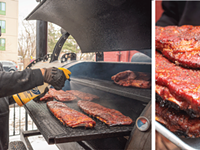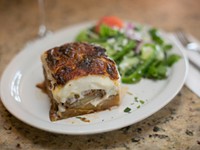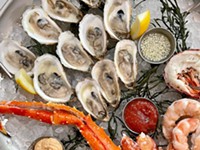Out of the ashes
After a fire destroyed their first restaurant, the owners of Haveli Indian Cuisine have a bona fide hit
By James Leach[
{
"name": "500x250 Ad",
"insertPoint": "5",
"component": "15667920",
"parentWrapperClass": "",
"requiredCountToDisplay": "1"
}
]
At the risk of invoking a tired cliché, Henrietta's newest Indian restaurant really is a phoenix from the ashes. Brothers Gurpal and Harcharnjid Singh opened their first restaurant, Namaste Diner, on West Henrietta Road in July 2008, an outgrowth of their successful Indian grocery store down the road. A bit over three months later, a kitchen fire closed the restaurant "indefinitely." By the end of the year, Namaste had been closed permanently. Late last year, Wild Noodles on East Henrietta Road closed its doors, and the Singh brothers took over the lease on the space, resurrecting their restaurant and restyling it Haveli Indian Cuisine.
Havelis, private mansions built for India's oldest and richest families, have the popular cache of Indian opulence and luxury. The brothers Singh played on this image in naming their restaurant. They offer a rich and varied cuisine embracing dishes from northern to southern India, and even reaching as far as the United Kingdom, where Balti cuisine originated. There are humble dishes like chana masala and saagpaneer, and more opulent dishes full of rare spices and cream, like chicken kesari and lamb rogan josh. You can even find northern and southern Indian street food like chaat and dosas. But the former Wild Noodles space, with its leftover décor and sticky floors, is far from a mansion. The brothers have done their best to dress the place up with white table cloths and cloth napkins, but the feel of a takeout joint lingers. The good news is that once you tuck into a plate of Gurpal Singh's chaat you'll forget all about the location's shortcomings.
Chaat is the equivalent of fast food all over northern India. Made at streetside stalls from ready-made ingredients including roasted potato, fried bits of bread (papri), or fried puffs of bread (puri), in addition to chana (chickpeas), gram beans, and a combination of raita, tamarind, and cilantro-mint chutneys and a sprinkle of chili powder or cayenne for that final zip, chaat is food on the fly -- fast, tasty, filling, and above all, cheap.
Gurpal Singh, the chef at Haveli, offers five different kinds of chaat: papribhalla, belpuri, dahivada, chana, and samosa chana -- all intensely flavorful and instantly addictive (chaat, $2.99-$6.99, most $3.99). In addition, on the lunch buffet ($8.99-$9.99) and dinner buffet ($11.99, Mondays and Tuesdays only) diners have the opportunity to assemble their own chaat from an array of ingredients, including puffy, crunchy puri and vadai (lentil doughnuts).
From the other end of the country comes dosas -- a full page of them on the menu, bewildering in their variety and number. The main variation between dosas is thickness: masoordosas are about as thick as a crepe, and ravadosas are paper thin, almost cracking apart at the touch of a finger. Masala dosas of both varieties are intensely spicy. Spring dosas are filled with fresh vegetables. All of them are gigantic. Our rava masala dosa was surely 16" from end to end and nearly 10" wide, a massive crepe folded over on itself in thirds and filled with a bright yellow, fragrant mixture of curried potatoes ($7.49). True to its kind, the crepe was nearly translucent, yet surprisingly durable, fully capable of acting as a scoop for the potatoes within. I'm not sure how anyone could eat this as street food without someone to help them hold it, but for food like this it's worth sitting down (dosas, $5.49-$7.99).
In addition to these delights, Haveli turns out a solid selection of Indian restaurant stand-bys, including a chicken makhani, where the butter and not the tomato took the front seat, wonderfully balanced and utterly delicious ($10.99). A subtle variation on the same dish, chicken kesari adds toasted mustard seeds and whole curry leaves to the mix, pushing the tomato into an even quieter supporting role in a dish bursting with both fire and the scent of curry ($10.99). Malaikofta, another standby, was prepared in a perfectly creamy sauce, the paneer and lentil dumplings tender and savory ($10.99). A more unusual variation on roughly the same theme, kadipakora, combined vegetable fritters with a tangy, yellow yogurt sauce enriched with turmeric, garam masala, and a bit of grated ginger ($8.99). Even the navrattan korma -- that traditional dumping ground for leftover vegetables -- was first rate, full of fresh veggies and clean, rich flavors ($10.99).
The saagpaneer and the chana masala were the only disappointing dishes on the traditional menu. The saagpaneer, a dish made of pureed spinach combined with cubes of Indian cheese, is usually full of deep flavors and most of the time chock full of paneer ($9.99). The portion I had from the fresh pan on the lunch buffet was bland and devoid of tasty cheese. Until I tasted the chana masala here, I'd never had a version of the dish that I didn't love. Like the spinach, this lacked flavor, with the disagreeable grainy texture of chickpeas stewed until they broke apart and started to dissolve ($9.99). Fortunately, two dishes were not enough to sway my overall favorable impression of Gurpal Singh's talents as a chef.
Until I ate at Havali, I was unaware that Chinese food was popular in India. Just as Chinese immigrants adapted their cuisine to American tastes and ingredients, Chinese immigrants to Kolkata created a cuisine appealing to the Indian palate. Some of those dishes are now finding their way into American Indian restaurants, as reflected by the small selection of "Manchurian" dishes on Singh's menu.
The gobi Manchurian, for instance, looked strangely familiar ($7.99). Both my companion and I thought we'd gotten the wrong dish: what had been put in front of us looked like General Tso's chicken or sesame chicken, not like anything we'd ever seen in an Indian restaurant. The preparation is similar to sesame chicken, although apparently cauliflower (gobi) is often substituted for meat in deference to India's large vegetarian population. Cumin, coriander (both fresh and ground), onions, green chilies, and a bit of tamarind (to give it that sweet and sour bite) are stir-fried along with chunks of cornstarch-battered, fried cauliflower, creating a dish that is recognizably "Chinese" (to the extent that the American-born General Tso's chicken can be said to be Chinese) but entirely, even forcefully, Indian. The only question is how an American Chinese dish found its way to Chinese restaurants in India....
Speaking of...
-

Snack attacks at House of Whacks
Jun 1, 2021 -

Cuomo loosens capacity restrictions on restaurants
Mar 8, 2021 -

A brick-and-mortar Bubby’s BBQ is open for business in The Wedge
Feb 1, 2021 - More »
Latest in Dining Reviews
More by James Leach
-

DINING REVIEW: Orange Glory Cafe
May 15, 2013 -

Dish 2013: Updating the kiddie menu
May 8, 2013 -

DINING REVIEW: Opa Authentic Greek Koozina
May 1, 2013 - More »


